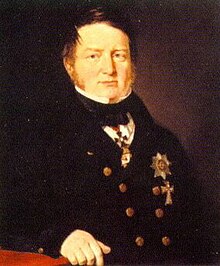Friedrich Georg Wilhelm von Struve
Friedrich Georg Wilhelm von Struve | |
|---|---|
 Von Struve | |
| Born | 15 April 1793 |
| Died | 23 November 1864 (aged 71) |
| Nationality | Baltic German[1] |
| Citizenship | Danish, Russian[2] |
| Alma mater | Imperial University of Dorpat |
| Awards | Gold Medal of the Royal Astronomical Society (1826) Royal Medal (1827) |
| Scientific career | |
| Fields | astronomy, geodesy |
Friedrich Georg Wilhelm von Struve (15 April 1793 – 23 November 1864 (Julian calendar: 11 November)) was a German-born Russian astronomer. He was born in Altona (now an area of Hamburg), Germany, but later lived in Russia. He was an expert on double stars and one of the first astronomers to measure stellar parallax (closely related to the work by Friedrich Bessel).
While director of Dorpat Observatory (1817–39) he wrote Stellarum Duplicum et Multiplicum (1837), which proved that double stars are not exceptional and that star systems are governed by the laws of gravity. Struve added a lot to the study of galactic structure and also engaged in notable geodetic operations such as the triangulation of Livonia and the measurement of an arc of the meridian. In 1839 he became director of the new Pulkovo Observatory and was one of the first three astronomers who almost simultaneously obtained an approximate stellar parallax. (One of the others being Bessel)
In 1822 he published the first of many double-star catalogues, the identifying numbers of which are still used today. Struve's stars, however, are now often named in his honor (for example, Struve 2398), whereas the original catalogue prefix was the Greek letter sigma. In 1833 he moved to Russia to set up the Pulkovo Observatory near St. Petersburg, of which he was director until his retirement in 1862, when his son took over in the post. In total, Friedrich Struve produced 272 astronomical works and 18 children; his great-grandson Otto, by contrast, produced 907 works but zero children.
His son, Otto Wilhelm von Struve (1819–1905) succeeded him as director (1862–89) of the Pulkovo Observatory.
References[change | change source]
- ↑ Erki Tammiksaar. "Baltic German natural scientists in the science system of the Russian empire". Estonian Institute. Archived from the original on 31 March 2012.
- ↑ Batten, Alan Henry (1988). Resolute and undertaking characters: the lives of Wilhelm and Otto Struve. Dordrecht, Holland: Springer. p. 9. ISBN 978-90-277-2652-0.
Other websites[change | change source]
- Henry Batten (1988). Resolute and undertaking characters: the lives of Wilhelm and Otto Struve. Springer. ISBN 90-277-2652-3.
 Media related to Friedrich Georg Wilhelm Struve at Wikimedia Commons
Media related to Friedrich Georg Wilhelm Struve at Wikimedia Commons- Works by or about Friedrich Georg Wilhelm von Struve in libraries (WorldCat catalog)
